The Nexus 7 (2013) Review
by Anand Lal Shimpi on August 22, 2013 6:00 PM ESTCPU Performance
The while the original Nexus 7 was fast for the money, the new Nexus 7 is just fast. Moving away from NVIDIA to Qualcomm, ASUS and Google settled on the APQ8064 Pro. Although we originally assumed this would be a quad-core Krait 200 based SoC, Brian's teardown revealed the part number 8064-1AA. What's special about that part number is it implies newer Krait 300 cores, making the SoC effectively a Snapdragon 600.
The CPU cores can run at up to 1.5GHz, putting it a bit lower than what we've seen from Snapdragon 600 based phones (e.g. HTC One tops out at 1.7GHz, while the US SGS4 hits 1.9GHz).
I was curious as to the impact of the lower frequency when combined with the potentially higher chassis TDP so I compared the Nexus 7 to the US Galaxy S 4. I turned to Geekbench because it offers a nicely woven mixture of single and multithreaded benchmarks, letting me look at peak available single core performance as well as what happens when multiple cores are active and working.
In this first graph we're looking at the first Krait 300 core running the workload. I've zoomed in to a small portion of the benchmark so we can get a better idea of CPU behavior:
The Nexus 7's CPU0 is almost always pegged at 1.5GHz whereas we see a lot of bursty thermal management on the smaller SGS4. This isn't unexpected, but what ends up happening is the sustained performance advantage drops from a peak theoretical max of 26% down to a more reasonable average gain of ~8%.
I was curious to see if multithreaded workloads showed any different behavior. Here we're looking at the fourth CPU core (CPU3). Note that it's not always active, which is why you see parts of the graph drop down to 0KHz. Once again we see similarly static behavior from the Nexus 7. Even with all four cores active, when you need the performance the Nexus 7 delivers a full 1.5GHz. These tests are short enough where we don't see tremendous swings in frequency, but once again we do see some frequency modulation in a smaller chassis.
The end result is that the Nexus 7's 1.5GHz Krait 300 cores are slower than what you'd get in a Galaxy S 4, however the gap isn't nearly as large as you'd expect it to be thanks to the larger chassis and how the platform is tuned. The Nexus 7 can run at 1.5GHz more consistently than Snapdragon 600 based phones can run at 1.7/1.9GHz.
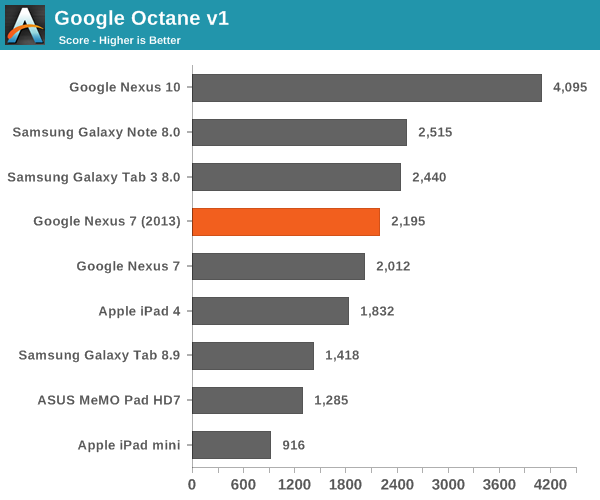


The GPU
Qualcomm seems to be frequency binning here, which is standard industry practice. Using binning to create these different SKUs gives Qualcomm pricing flexibility and also gives it the option to give large customers special treatment.
On the graphics side Qualcomm's Adreno 320 GPU makes an appearance. Clock speeds are also limited to 400MHz, compared to 450MHz for the high-end Snapdragon 600 implementations we've seen.
The APQ8064-1AA's dual-channel memory controller is populated with four x 16-bit DDR3L-1600 memory devices, giving the Nexus 7 a healthy amount of memory bandwidth. Peak memory bandwidth available to the APQ8064-1AA is 12.8GB/s, equalling what's available to Apple's A5X in the 3rd generation iPad with Retina display. Tons of memory bandwidth is obviously a pre-requisite for driving a high resolution display, and the combination of DDR3L-1600 and the Adreno 320 GPU delivers a butter smooth UI in all well written Android apps.
Although CPU performance is somewhat middle of the road compared to the rest of the landscape, GPU performance is faster than any other Nexus device on the market - and pretty much faster than any other similarly sized tablet:
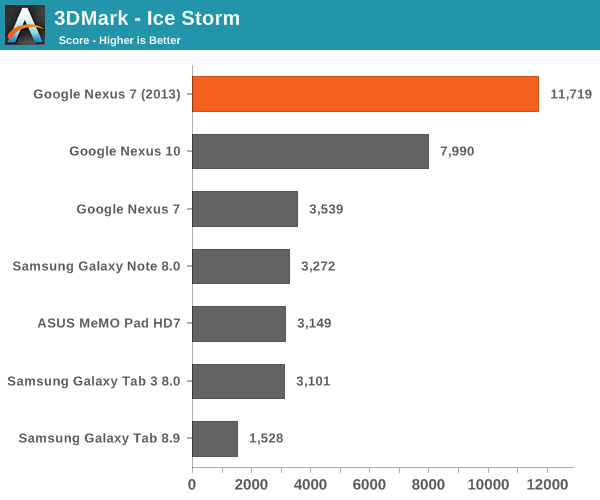
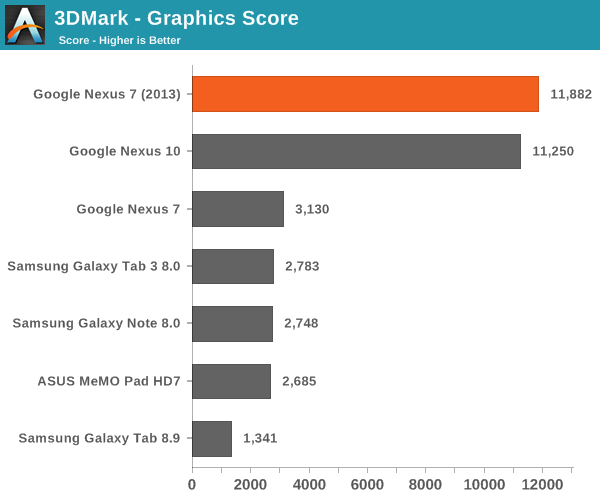
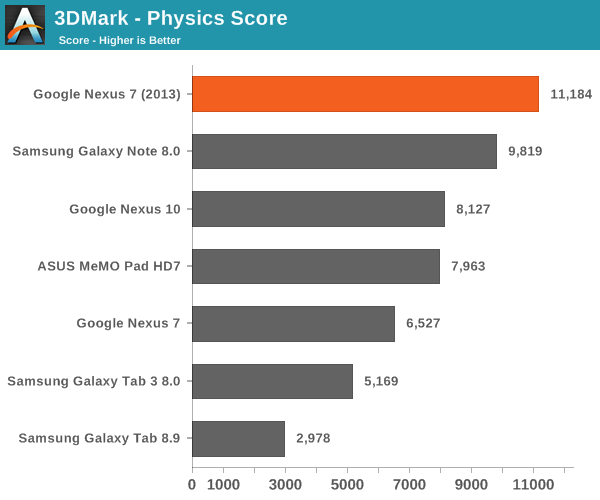
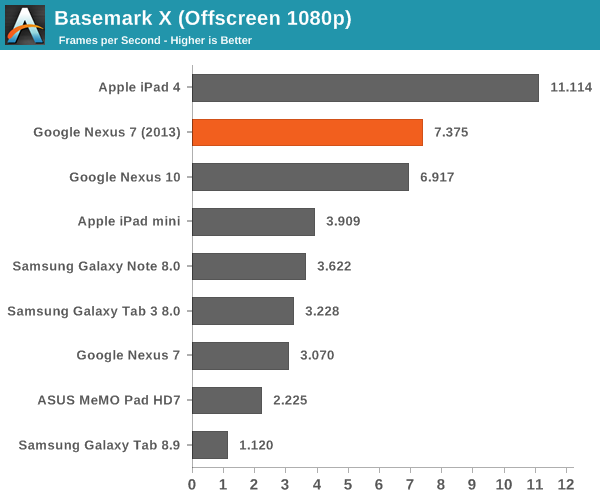
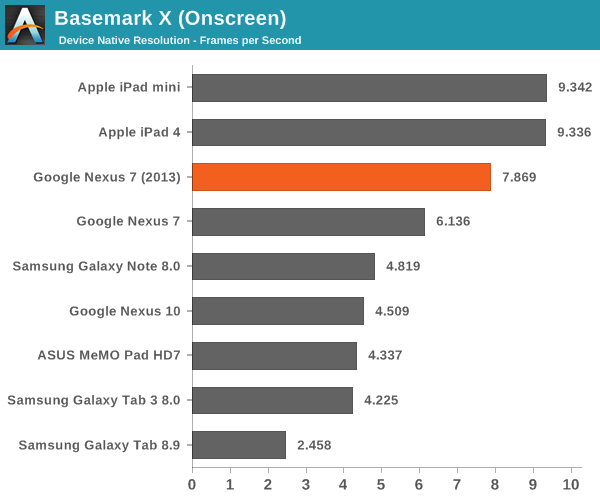
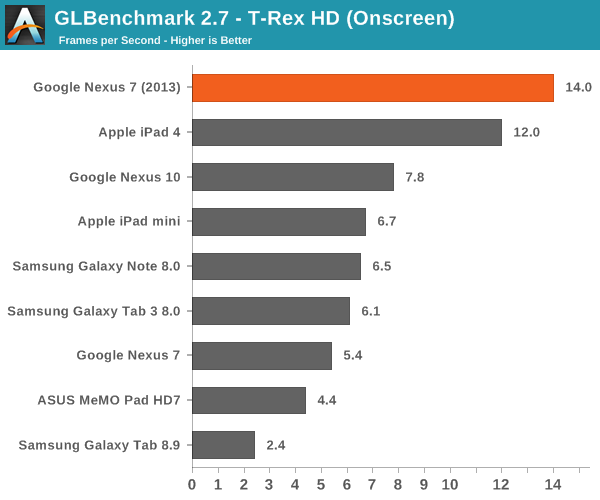
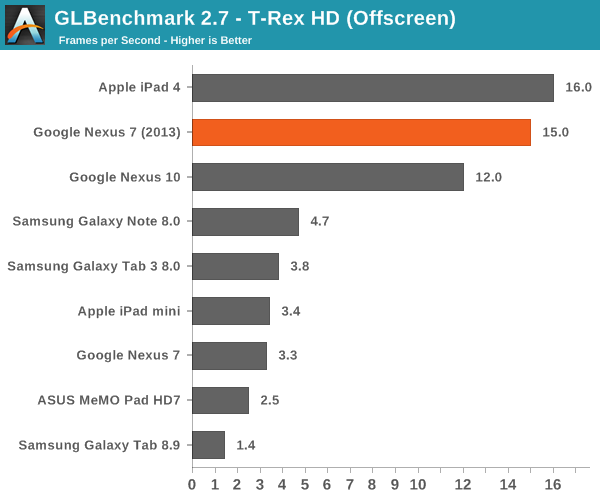
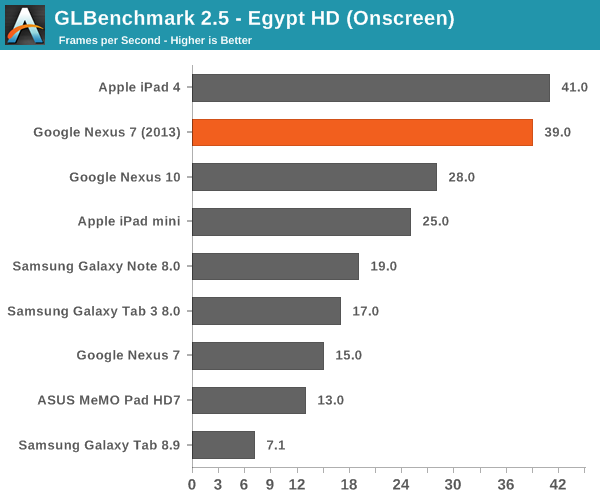
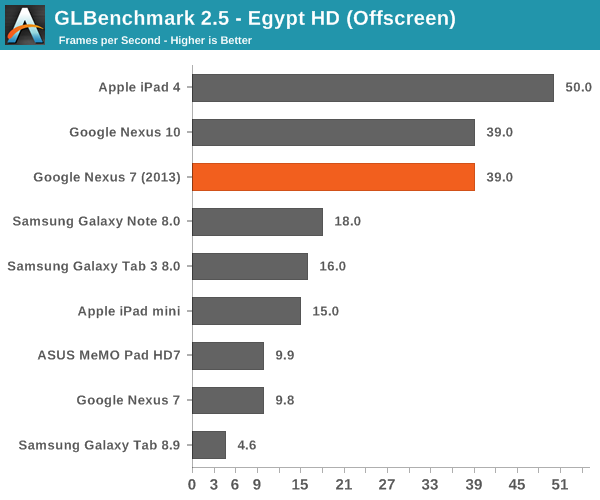
I played Modern Combat 4 as well as Shadowgun, both demanding 3D titles, on the new Nexus 7. Both titles appeared to render at the Nexus 7's native 1920 x 1200 resolution, and both appeared to do so at around 30 fps.


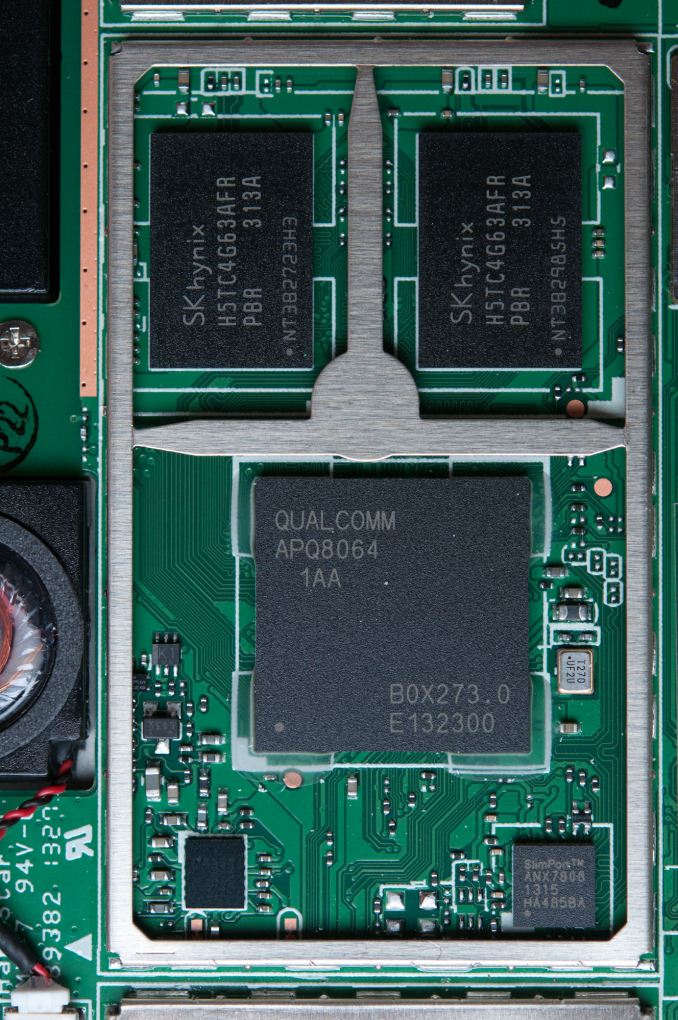
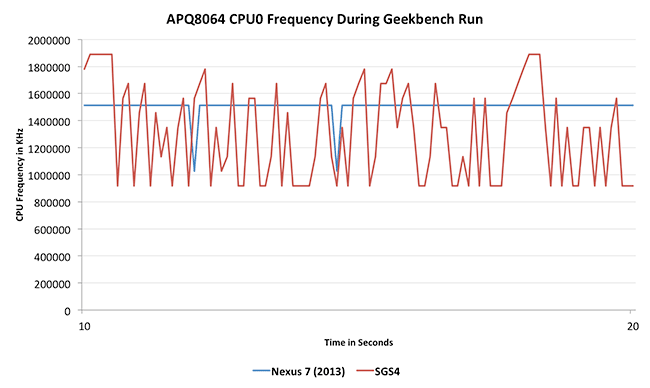
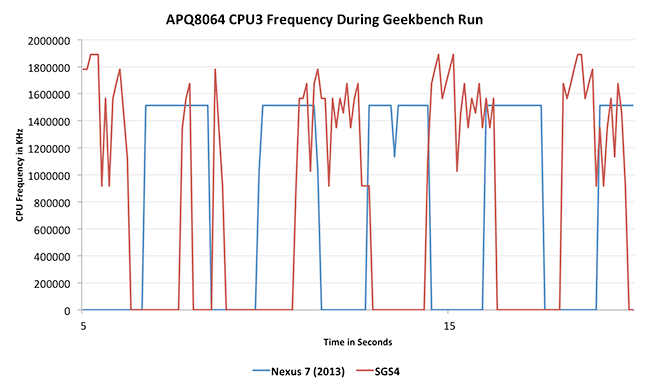








202 Comments
View All Comments
ESC2000 - Wednesday, August 28, 2013 - link
Actually I have. Go look at the picture on the first page of Anand's review. .. the nexus 7 shows a few more lines of the anandtech website than the mini. I'll admit that it should be more if what I said was absolutely true (ie, every the nexus shows 2x more pixels) but even if the nexus doesn't take full advantage of its pixel density, it still beats the ipad mini in how much it shows on the screen in most situations.ESC2000 - Monday, September 9, 2013 - link
You do realize that selling more each iteration does not mean apple isn't losing market share since the tablet market has been growing exponentially... It's the same as how each iPhone sells more than the last but still iOS loses market share each year. If apple sells 5 million iPads in one quarter out of 10 million total tablets sold and then sells 6 million iPads the next out of 20 million sold, apple sold more in the second quarter but lost market share.WarpGuN - Friday, August 23, 2013 - link
in your dreamskascollet - Saturday, August 24, 2013 - link
Please stop spoiling this excellent tech-site. You don't belong here man.jl0329 - Wednesday, October 9, 2013 - link
You clueless dumb shit.KPOM - Thursday, August 22, 2013 - link
The iPad mini is at the end of its product cycle.The Nexus 7 is at the beginning. Let's hold off for a month or so to see what Apple has in store before complaining that Anand didn't compare (no pun intended) apples to apples. True, if you are in the market today, what's on tap for next month is irrelevant, but even the mainstream sites latch on to rumors today, so most people realize that the WSJ/AllthingsD essentially leaked that the iPad is due for a refresh.sherlockwing - Friday, August 23, 2013 - link
A month? I guess you haven't read the recent reports that the Retina Mini is pushed back to early 2014? iOS7 tablet apps is also lagging significantly behind iOS7 phone apps.abazigal - Sunday, August 25, 2013 - link
Those remain unsubstantiated rumours. Besides, the next ipad isn't even announced yet. Expect apps to be rapidly updated once it is announced.EnzoFX - Friday, August 23, 2013 - link
The comparison's to the ipad 4's screen is incredibly welcomed. I wanted the comparison quantified. Color accuracy I care about, the iPad 4 set the bar. There may be no cross-shopping, but for those that want a great calibrated screen, now we have 2 real options.danderson10k - Thursday, August 22, 2013 - link
Another series of Android tablets to launch this month from tablet-maker Pipo Electronics, stand out for excellent build quality and price-performance -- the Pipo M7 Pro ($255) which for roughly the same price as the new Nexus 7, features an 8.9 inch display with 1900X1200 screen resolution that uses advanced Samsung PLS technology, along with a Quad core processor, and built-in GPS navigation -- and is packed with features that compare to the new Nexus... offering premium speakers, WiFi with both 2.4 and 5.0 GHz frequencies for greater connection, as well as the choice of using standard Android O/S or a Windows style User Interface that makes the Android experience much more intuitive and easier to use --The Pipo M9 Pro ($285) model offers a 10 inch version that compares closely to the new Nexus 10 and 3G HSPA+ is available with either model for $25 more and work with any GSM Carrier, including T-Mobile and AT&T, and an Android phone SIM card maybe used interchangeably with both phone and tablet.
One of the first sources to carry the new Pipo tablet series is -- T a b l e t S p r i n t –- which also features a new Miracast TV adapter($39) that launched this week, which is similar to Google Chromecast -- but with a lot more features and performs much more like Apple's Airplay technology...